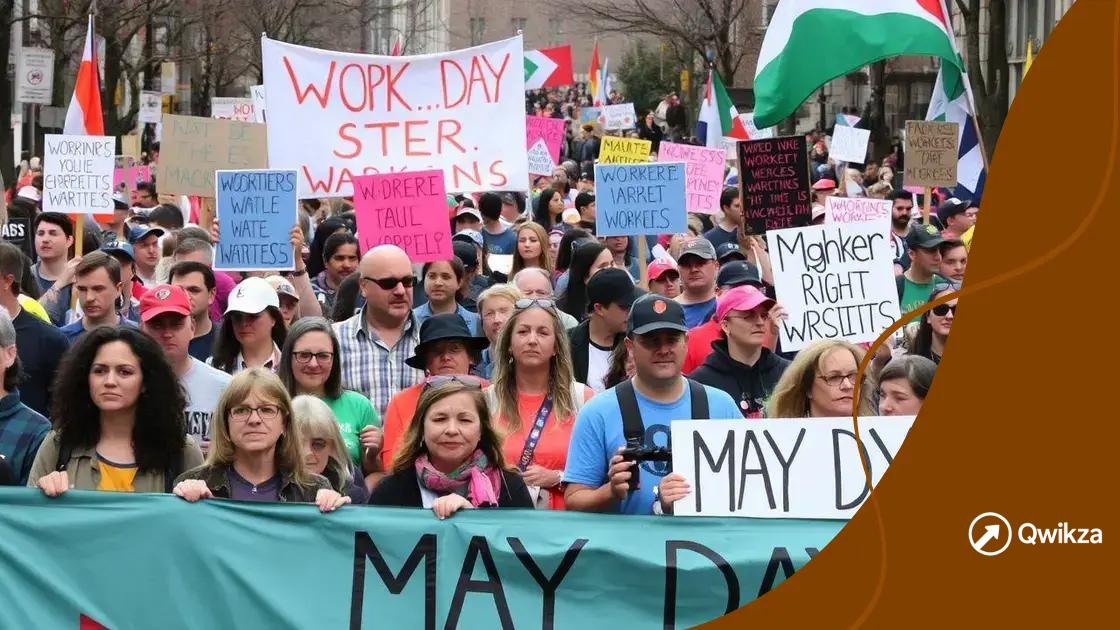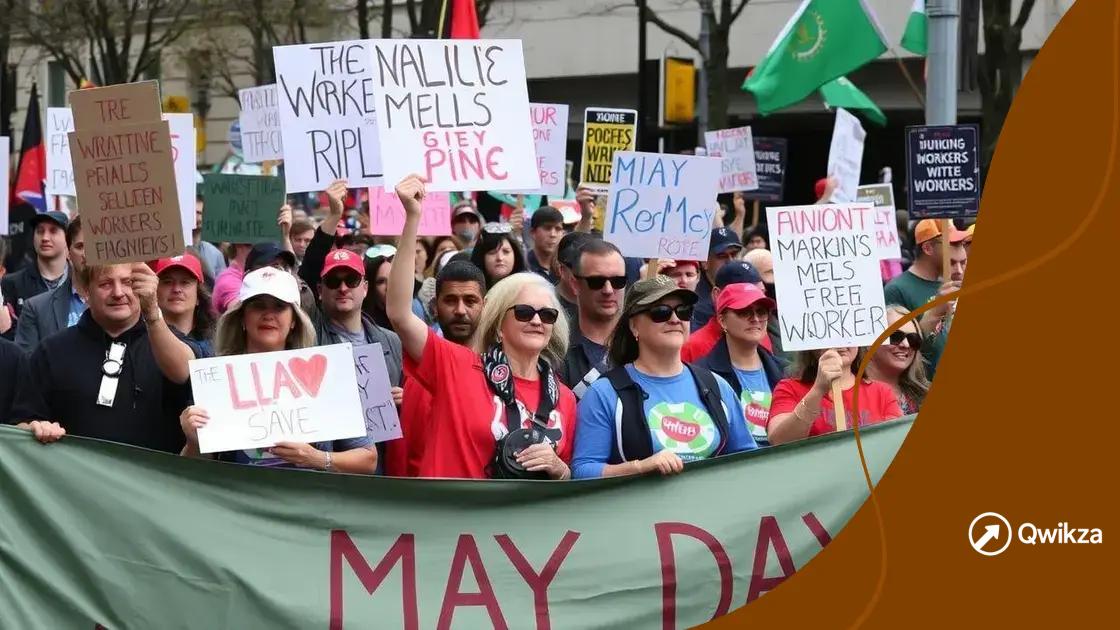May Day demonstrations held across the country

May Day demonstrations are global events advocating for workers’ rights, highlighting issues like wage disparity and workplace safety, and serving as a platform for unions to influence policy changes.
May Day demonstrations held across the country bring together people united in the call for justice and workers’ rights. Have you noticed how these events resonate with our daily lives? Let’s delve into what these gatherings mean for us today.
The history of May Day demonstrations
The history of May Day demonstrations is rich and diverse, reflecting the struggles and victories of workers around the world. These celebrations, held on May 1st, have significant roots tracing back to labor movements advocating for workers’ rights and better working conditions.
In the late 19th century, May Day became a day for labor activists to unite. One pivotal moment was the Haymarket Affair in Chicago in 1886, where protests for an eight-hour workday turned tragic. This event solidified May Day as a crucial symbol for labor rights. Over time, various countries began to honor this day, with each adding unique traditions.
The significance of May Day
May Day serves as a reminder of the ongoing fight for worker rights. Many use it to promote awareness on issues like wage equality and safe working conditions. Today, May Day is celebrated in many parts of the world with rallies, speeches, and festivities.
- Labor movements have shaped the significance of this day.
- May Day honors historical worker struggles.
- Countries celebrate with their unique customs.
Many regions have declared May Day a public holiday, allowing workers and activists to mobilize and advocate for change. For instance, in countries like France, Germany, and Italy, the day is filled with parades and demonstrations, showcasing solidarity among workers.
Modern May Day demonstrations
In recent years, May Day demonstrations have evolved, focusing not just on workers’ rights, but also on broader social issues. Activists around the globe gather to protest against economic disparities, discrimination, and various forms of injustice. The participation usually spans a wide demographic, illustrating the collective fight for equality.
As enthusiasm continues to grow, it becomes clearer how this day, rooted in a strong historical background, remains a platform for change. Each year, thousands join in, keeping the spirit of solidarity alive.
Key issues raised in recent protests
In recent years, May Day demonstrations have brought various crucial issues to the forefront of public awareness. These protests not only highlight labor rights but also address broader social challenges affecting communities worldwide.
One of the key issues raised is wage disparity. Activists argue that many workers are not receiving fair compensation for their efforts. This growing concern has led to discussions about raising the minimum wage and ensuring that salaries align with the cost of living.
Workers’ Rights and Safety
Another significant topic is the need for improved worker rights and safety regulations. Many demonstrators emphasize that workers should feel safe in their environments. This includes proper training for handling machinery, access to protective equipment, and fair working hours.
- Ensuring safe working conditions is vital.
- Training and protective gear must be provided.
- Fair working hours should not be overlooked.
Environmental justice has also gained traction during these protests. Many participants link the struggles of workers to the health of the planet. They argue that low-income communities often face the most significant pollution and environmental hazards. This connection has sparked calls for regulations that protect both workers and the environment.
Equality and Representation
Lastly, a strong emphasis on equality and representation has become a focal point. Protesters advocate for inclusivity within the workplace, demanding that marginalized groups receive a fair voice in labor discussions. This call for representation aims to ensure that all workers feel valued and heard.
These issues are interconnected and require collective action to address them effectively. As demonstrations continue, the push for change highlights the importance of uniting voices across different sectors for a common cause.
The role of unions in May Day events

Unions play a vital role in May Day events, acting as a voice for workers’ rights and solidarity. These organizations unite individuals to advocate for fair wages, safe working conditions, and overall equality in the workplace.
During May Day, unions mobilize members to participate in demonstrations, ensuring that their collective voice is heard. They organize rallies, march with banners, and distribute flyers highlighting key issues affecting workers. This participation is an important aspect of raising awareness not only for union members but also for the general public.
Advocacy and Representation
One of the main functions of unions during these events is advocacy. They represent the interests of workers and lobby for legislation that protects labor rights. Through collective bargaining, unions work to secure better pay and benefits for their members. Demonstrations on May Day serve as a platform to showcase these efforts, attracting media attention and public support.
- Unions help amplify workers’ concerns.
- They fight for fair legislation.
- Collective bargaining leads to tangible improvements.
In addition to advocacy, unions foster a sense of community among workers. By bringing people together during May Day events, they strengthen bonds and build networks that support various initiatives. This unity is vital, as it enhances the power of the message being delivered.
Education and Awareness
Unions also play a crucial role in educating the public about labor issues. They host workshops and distribute materials that inform people about their rights as workers. This educational aspect is essential during May Day, as it encourages greater participation and activism among the workforce.
As global challenges evolve, the role of unions in May Day events remains significant. They continue to adapt to new labor realities while staying committed to their fundamental principles of justice and equality for all workers.
Global perspectives on May Day celebrations
May Day is celebrated around the world, showcasing a variety of perspectives and traditions. Each country has unique customs that reflect its culture and history regarding labor rights and worker solidarity. Understanding these global perspectives helps to appreciate the significance of May Day celebrations.
In many countries, May Day is a public holiday, with workers taking to the streets to participate in parades and rallies. For instance, in France, the day is marked with demonstrations where labor unions march, advocating for workers’ rights. The atmosphere is filled with speeches, music, and a strong sense of community among participants.
May Day in Different Countries
In Germany, May Day, or “Tag der Arbeit,” is also a significant event. People gather for street festivals and events aimed at promoting social justice. This day serves as an important reminder of the labor movement’s struggles and achievements in the country.
- France celebrates with vibrant parades led by unions.
- Germany’s events blend protest and celebration.
- International solidarity is emphasized in speeches.
In the United States, May Day has faced challenges in gaining recognition, often overshadowed by Labor Day in September. However, many activists seize the opportunity to organize demonstrations focused on immigrant rights and social justice. The use of May Day to address these issues highlights the continued struggle for equality among diverse groups.
Latin American Traditions
Latin American countries also have their own rich traditions on this day. For example, in Mexico, May Day is celebrated with speeches and educational events focused on workers’ conditions and rights. It is a day that unites labor organizations, allowing workers to voice their demands for fair treatment.
As the world evolves, May Day celebrations continue to adapt, reflecting both historical traditions and current social issues. The global diversity in celebrating this day emphasizes the universal quest for justice and equality among workers.
Impact of May Day demonstrations on policy changes
The impact of May Day demonstrations on policy changes is significant and notable. As these events gather thousands of participants, they draw attention to urgent labor issues that often lead to necessary reforms and new policies. Through collective action, workers express their demands for fair treatment, better wages, and improved working conditions.
Historically, May Day has been a catalyst for change. For example, following large demonstrations, many countries have adopted laws that protect workers’ rights. This includes regulations on working hours, safety standards, and anti-discrimination measures. Advocacy during May Day events demonstrates the unity and strength of workers, influencing lawmakers to take action.
Recent Policy Changes
In recent years, the demands from May Day events have sparked discussions on various policy initiatives. Many activists push for raising the minimum wage to ensure that workers can afford basic living expenses. The message is loud and clear: workers deserve fair compensation for their contributions.
- Increase in minimum wage debates.
- Stronger safety regulations in the workplace.
- Policies aimed at reducing workplace discrimination.
Moreover, the visibility of these demonstrations has helped to amplify voices advocating for environmental justice alongside labor rights. This connection invites policy discussions that address not only economic inequalities but also the health of the planet. Activists emphasize the importance of sustainable practices that also benefit workers.
Mobilizing for Change
Moreover, May Day demonstrations create a platform for coalitions between labor organizations and community groups. By joining forces, these movements can leverage their combined political power to influence reforms. This collaboration allows for a broader approach to policy changes, striving for equality across multiple fronts.
As May Day continues to highlight labor concerns, the ripple effects on policy and society can lead to long-lasting changes. The ongoing participation of activists showcases a commitment to not only improving labor conditions but also challenging systemic issues affecting all workers.
In conclusion, the impact of May Day demonstrations extends far beyond the streets where they occur. These gatherings highlight the collective strength of workers and bring essential issues like wage equality and safety into the spotlight. By mobilizing for change, participants demonstrate their commitment to advocating for rights, not only for themselves but for future generations. The ongoing push for policies that protect workers and the environment illustrates the vital link between labor activism and social justice. As May Day continues to evolve, it remains a powerful symbol of solidarity and hope for a better future.
FAQ – Frequently Asked Questions about May Day Demonstrations
What is the significance of May Day demonstrations?
May Day demonstrations are important events that advocate for workers’ rights, pay equality, and improved working conditions across the globe.
How do May Day protests influence policy changes?
These protests gather large crowds, drawing attention to critical labor issues, which can lead lawmakers to make necessary reforms and adopt new policies.
What issues are commonly raised during May Day events?
Common issues include wage disparity, workplace safety, and environmental justice, often highlighting the interconnectedness of labor rights and social justice.
How do unions participate in May Day celebrations?
Unions play a vital role by organizing demonstrations, advocating for workers, and educating the public about labor rights and needs.
